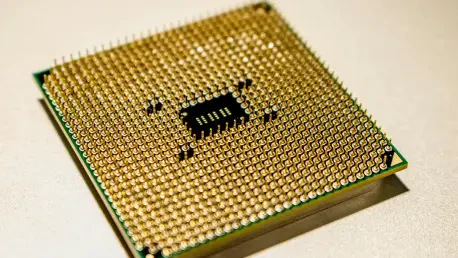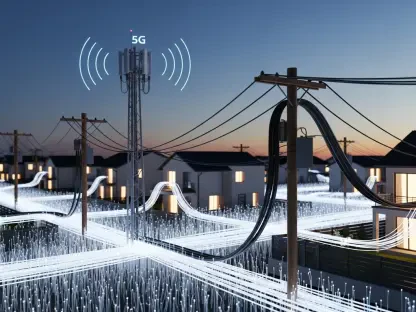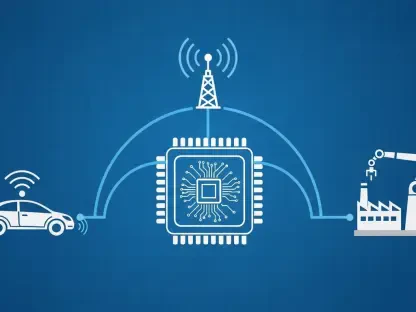In an era where digital connectivity defines daily life, imagine a world where downloading an entire high-definition movie takes mere seconds, or where seamless virtual reality experiences are accessible anywhere without a hitch. A groundbreaking development in wireless technology is poised to turn this vision into reality with the introduction of a minuscule 6G chip that promises to deliver speeds up to 500 times faster than current 5G averages. Developed through a collaborative effort by researchers from the United States and China, this innovation marks a significant leap forward in the quest for next-generation communication networks. The chip’s potential to redefine how data is transmitted and received could transform industries ranging from telecommunications to healthcare, setting the stage for a future of unprecedented connectivity. This advancement not only highlights the rapid pace of technological progress but also raises critical questions about the infrastructure and scalability needed to bring such power to the masses.
Unveiling the Power of 6G Technology
Revolutionizing Speed and Connectivity
The core of this technological breakthrough lies in the chip’s ability to achieve staggering data transfer rates, reaching up to 100 Gbps, a figure that dwarfs the average 5G speeds of 150 to 300 Mbps. This ultrabroadband chip operates across an expansive frequency spectrum, spanning microwave, millimeter wave, and terahertz bands, covering over 100 GHz. Such a wide range ensures continuous connectivity in varied environments, making it a versatile solution for future wireless networks. Unlike 5G, which struggles to consistently hit its theoretical peak of 10 Gbps, this 6G innovation offers a reliable pathway to speeds that could transform how data-intensive applications are handled. From enabling real-time augmented reality in crowded urban centers to supporting massive IoT ecosystems, the implications of this speed are vast. This development stands as a testament to the relentless pursuit of faster, more efficient communication systems that can keep pace with growing global demands.
Addressing Complex Spectrum Challenges
Beyond sheer speed, the chip’s real-time reconfigurability sets it apart as a game-changer for managing complex spectrum environments. Its design allows for seamless adaptation across nine consecutive frequency bands, ensuring stability and coherence even in challenging conditions. This adaptability is crucial for future networks expected to handle an ever-increasing volume of data streams from diverse sources. By integrating a thin-film lithium niobate photonic system, the chip facilitates broadband wireless-photonic conversion, turning radio signals into optical ones with remarkable precision. This addresses longstanding limitations in bandwidth coverage that have hindered previous wireless technologies. As a result, it paves the way for full-spectrum networks capable of supporting omni-scenario applications, from smart cities to remote industrial operations. The technical sophistication behind this innovation underscores the potential for 6G to become the backbone of tomorrow’s digital infrastructure.
Overcoming Barriers to 6G Implementation
Navigating Technical and Production Hurdles
While the capabilities of this 6G chip are undeniably impressive, the journey from laboratory success to widespread adoption is fraught with challenges. One of the primary obstacles lies in scaling production to meet global demand, as the chip’s intricate design—measuring just 11 mm by 1.7 mm—requires advanced manufacturing techniques that are not yet widely available. Additionally, integrating this technology into existing infrastructure poses significant logistical issues, as current systems are built primarily for 5G and earlier generations. The transition to 6G will demand substantial investments in new hardware and network architectures, a process that could take years to complete. Researchers estimate that operational 6G networks might emerge between 2030 and 2032, though these timelines remain speculative given the complexities involved. Balancing the excitement of this innovation with the practical realities of deployment is essential for setting realistic expectations in the tech community.
Building the Infrastructure for Future Networks
Another critical barrier to 6G implementation is the need for a robust infrastructure capable of supporting such advanced technology. Unlike incremental upgrades seen in past network transitions, the shift to 6G requires a complete overhaul of base stations, antennas, and data centers to accommodate the chip’s high-frequency operations and massive bandwidth. This overhaul extends beyond hardware to include regulatory frameworks and spectrum allocation policies, which must evolve to prevent interference and ensure equitable access. The collaborative nature of this project, involving experts from multiple countries, highlights the global scale of effort needed to bring 6G to fruition. Without coordinated international action, disparities in network readiness could widen, leaving some regions lagging behind. Addressing these infrastructure challenges will be pivotal in determining whether the transformative potential of 6G can be fully realized within the projected timelines, ensuring that the benefits of ultra-fast connectivity reach all corners of the globe.
Reflecting on a Milestone in Wireless Evolution
Charting the Path Forward
Looking back, the unveiling of this tiny 6G chip marked a pivotal moment in the evolution of wireless communication, showcasing the remarkable potential to achieve speeds 500 times faster than 5G averages. The collaborative ingenuity behind its design, blending cutting-edge photonic systems with broadband capabilities, set a new benchmark for what future networks could accomplish. Despite the hurdles of production and infrastructure, the groundwork laid by this innovation offered a clear vision of a hyper-connected world. The commitment to overcoming spectrum challenges and ensuring adaptability reflected a forward-thinking approach that prioritized long-term impact over immediate results. This milestone served as a reminder of the relentless drive to push technological boundaries, even when faced with daunting obstacles.
Envisioning Practical Next Steps
In the aftermath, attention turned to actionable strategies for bridging the gap between concept and reality. Stakeholders across industries began exploring partnerships to fund and develop the necessary infrastructure, recognizing that collaboration was key to accelerating 6G deployment. Investments in scalable manufacturing processes gained momentum, as did efforts to update regulatory standards for high-frequency bands. Pilot programs in select regions emerged as a testing ground for integrating this chip into real-world scenarios, providing valuable data on performance and reliability. These steps, though incremental, built a foundation for broader adoption, ensuring that the promise of ultra-fast wireless networks moved closer to becoming an everyday reality. The focus on practical solutions underscored a collective determination to transform this technological leap into tangible benefits for global connectivity.









